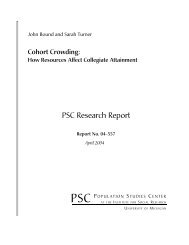successful aging and active aging in taiwan - Comparative Study of ...
successful aging and active aging in taiwan - Comparative Study of ...
successful aging and active aging in taiwan - Comparative Study of ...
You also want an ePaper? Increase the reach of your titles
YUMPU automatically turns print PDFs into web optimized ePapers that Google loves.
SUCCESSFUL AGING ANDACTIVE AGING IN TAIWANHEI-CHUAN HSUMING-CHENG CHANGTAICHUNG HEALTHCARE AND MANAGEMENTUNIVERSITY
Objective <strong>of</strong> the study.• To work out health <strong>and</strong> social <strong>in</strong>dicatorsfor <strong>successful</strong> <strong>ag<strong>in</strong>g</strong> <strong>and</strong> <strong>active</strong> <strong>ag<strong>in</strong>g</strong> <strong>in</strong>Taiwan.• To exam<strong>in</strong>e associations betweendemographic <strong>and</strong> socioeconomiccharacteristics <strong>and</strong> <strong>successful</strong> <strong>ag<strong>in</strong>g</strong> or<strong>active</strong> <strong>ag<strong>in</strong>g</strong>.
Def<strong>in</strong>ition.• Successful <strong>ag<strong>in</strong>g</strong> <strong>and</strong> <strong>active</strong> <strong>ag<strong>in</strong>g</strong> may bedef<strong>in</strong>ed as a “state <strong>of</strong> complete physical,mental, <strong>and</strong> social well-be<strong>in</strong>g”. In morespecific, <strong>successful</strong> <strong>ag<strong>in</strong>g</strong> is proposed tocover four health <strong>and</strong> social <strong>in</strong>dicatorsphysical function, cognitive function,melancholia, <strong>and</strong> social support. In additionto these four <strong>in</strong>dicators, <strong>active</strong> <strong>ag<strong>in</strong>g</strong><strong>in</strong>volves <strong>in</strong> an <strong>active</strong> participation <strong>in</strong> socialactivity.
Physical Health-ADL(IADL)normalSocial Health-Good Social Support-Labor forceparticipationSuccessful /Active Ag<strong>in</strong>gMental Health-Cognitive functionnormal-MelancholiaFigure 1. Three Dimensions for Successful <strong>and</strong> Active Ag<strong>in</strong>g
Data <strong>and</strong> Methods.1. Data <strong>and</strong> sampleThe Surveys <strong>of</strong> Health <strong>and</strong> Liv<strong>in</strong>g Status <strong>of</strong> the Elderly have beenconducted approximately three years s<strong>in</strong>ce 1989 (1993, 1996,1999, <strong>and</strong> 2003). Although the orig<strong>in</strong>al study focused on theelderly population (those 60 <strong>and</strong> above <strong>in</strong> 1989), the 1996 surveyadded a “nearly-elderly” cohort <strong>of</strong> persons aged 50-66, so <strong>in</strong> all,the study is now representative <strong>of</strong> the population age <strong>and</strong> aboveas <strong>of</strong> 1996. The response rate <strong>of</strong> follow-up <strong>in</strong>terviews <strong>in</strong> 1993,1996, <strong>and</strong> 1999 ranged from 88.9 to 90.1 percent. These surveys<strong>of</strong>fer a rich resource <strong>of</strong> <strong>in</strong>formation on the characteristics <strong>and</strong>experience <strong>of</strong> this population <strong>and</strong> have been used extensively tostudy the health, liv<strong>in</strong>g arrangement, <strong>and</strong> well-be<strong>in</strong>g <strong>of</strong> theelderly <strong>in</strong> Taiwan. For this study, we picked up the elderly aged70 <strong>and</strong> above <strong>in</strong> 1999. there are a total <strong>of</strong> 2,310 cases.
Data <strong>and</strong> Methods.The Surveys <strong>of</strong> Health <strong>and</strong> Liv<strong>in</strong>g Status <strong>of</strong> the Elderly havebeen conducted approximately three years s<strong>in</strong>ce 1989 (1993,1996, 1999, <strong>and</strong> 2003). Although the orig<strong>in</strong>al study focused onthe elderly population (those 60 <strong>and</strong> above <strong>in</strong> 1989), the 1996survey added a “nearly-elderly” cohort <strong>of</strong> persons aged 50-66,so <strong>in</strong> all, the study is now representative <strong>of</strong> the population age<strong>and</strong> above as <strong>of</strong> 1996. The response rate <strong>of</strong> follow-up<strong>in</strong>terviews <strong>in</strong> 1993, 1996, <strong>and</strong> 1999 ranged from 88.9 to 90.1percent. These surveys <strong>of</strong>fer a rich resource <strong>of</strong> <strong>in</strong>formation onthe characteristics <strong>and</strong> experience <strong>of</strong> this population <strong>and</strong> havebeen used extensively to study the health, liv<strong>in</strong>g arrangement,<strong>and</strong> well-be<strong>in</strong>g <strong>of</strong> the elderly <strong>in</strong> Taiwan. For this study, wepicked up the elderly aged 70 <strong>and</strong> above <strong>in</strong> 1999. there are atotal <strong>of</strong> 2,310 cases.
Data <strong>and</strong> Methods.2. Measure1) Physical health is measured ADL (activities <strong>of</strong> daily liv<strong>in</strong>g)<strong>and</strong> IADL (<strong>in</strong>strumental activities <strong>of</strong> daily activities). ADL ismeasured any difficulty <strong>of</strong> gett<strong>in</strong>g out <strong>of</strong> bed, st<strong>and</strong><strong>in</strong>g up,or sitt<strong>in</strong>g <strong>in</strong> a chair, dress<strong>in</strong>g <strong>and</strong> undress<strong>in</strong>g, go<strong>in</strong>g to thetoilet, bath<strong>in</strong>g, mov<strong>in</strong>g about the house, <strong>and</strong> bath<strong>in</strong>g. IADLis measured by any difficulty <strong>of</strong> buy<strong>in</strong>g personal use items(like soap, medic<strong>in</strong>e), man<strong>ag<strong>in</strong>g</strong> money, pay<strong>in</strong>g bill, rid<strong>in</strong>gthe bus or tra<strong>in</strong>, do<strong>in</strong>g physical work around the house, <strong>and</strong>us<strong>in</strong>g the telephone. If no difficulty <strong>of</strong> any <strong>of</strong> above items orthe duration <strong>of</strong> difficulty <strong>of</strong> any item less than three monthsis def<strong>in</strong>ed as a normal situation.
Data <strong>and</strong> Methods.2. Measure2) Mental health refers to cognitive function <strong>and</strong> melancholia.Its measurements are as follows(a) Cognitive function ismeasured by 10 questions (SPMSQ) regard<strong>in</strong>g address <strong>of</strong>residence, age, current president, <strong>and</strong> date <strong>of</strong> today ,etc.The scores ranges from 0-10 <strong>and</strong> are classified byeducational level to identify normal or abnormalEducation Normal Some problem Severe problemIlliterate 6-10 4-5 4 or belowPrimary 7-10 5-6 5 or belowJunior high <strong>and</strong> above 8-10 6-7 6 or below
Data <strong>and</strong> Methods.The normal situation refers to good cognitive function <strong>and</strong> is adimension <strong>of</strong> <strong>successful</strong> <strong>ag<strong>in</strong>g</strong><strong>and</strong> (b) Melancholia ismeasured CES. 10 questions such as not <strong>in</strong>terested <strong>in</strong> eat<strong>in</strong>g,have a poor appetitefeel that do<strong>in</strong>g anyth<strong>in</strong>g was exhaust<strong>in</strong>gunable to sleepfeel lonelyfeel people around you weren’tnice to you, etc. were asked to the elderly <strong>in</strong> the past week.Us<strong>in</strong>g the transformation <strong>of</strong> T-score (Kohout, et al., 1993), theelderly who got 8 scores or more is def<strong>in</strong>ed as hav<strong>in</strong>gmelancholia. Those whose scores 7 or less are normalsituation.
Data <strong>and</strong> Methods.3) Social well-be<strong>in</strong>gSocial well-be<strong>in</strong>g covers social support <strong>and</strong> exchange <strong>of</strong> support.In addition, social <strong>and</strong> labor force participation will be <strong>in</strong>volved..For social support <strong>and</strong> exchange <strong>of</strong> support, four dimensions will beconsidered(a) degree <strong>of</strong> satisfactory with the type <strong>of</strong> emotional orpsychological support received from family or relatives(b) degree <strong>of</strong>satisfactory with sick care <strong>and</strong> f<strong>in</strong>ancial assistance received fromfamily <strong>and</strong> relatives(c) listen<strong>in</strong>g your talk<strong>in</strong>g by your family orrelatives when you have problems or worries<strong>and</strong> (d) provid<strong>in</strong>gassistance to baby sit/ house chores/ sick care/ economic needs fordaily life. If there is positive response to 4 items, the rank<strong>in</strong>g <strong>of</strong>social support is top. For three items, the social support is middle.For two items or fewer, social support is low or none. In addition,the elderly who <strong>in</strong>volved <strong>in</strong> any <strong>of</strong> voluntary work or economicactivity is another <strong>in</strong>dicator <strong>of</strong> <strong>active</strong> <strong>ag<strong>in</strong>g</strong>.















